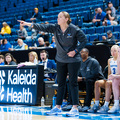‘Our hands are tied’: SUNY stability plan orders ESF staff cut, enrollment uptick

SUNY’s new stability plan requires ESF to alter programs and cut 18.9% of its full-time staff by 2029. Some ESF students and faculty called the plan a "betrayal" of investments into environmental education. Beomsu (Peter) Shin | Contributing Photographer
Get the latest Syracuse news delivered right to your inbox.
Subscribe to our newsletter here.
UPDATE: This post was updated at 5:35 p.m. on September 28, 2025.
For Matthew Smith, SUNY ESF’s director of college libraries, finding out the specialized school would lose more of its state funding didn’t come as a surprise.
In an August meeting with ESF President Joanne Mahoney, Smith learned about the broader SUNY system’s fiscal stability plan, which will cut faculty and alter ESF programs throughout the next five years.
“It’s not a spending problem. It’s a revenue problem,” Smith said. “Our hands are tied.”
SUNY’s stability plan orders ESF to cut 18.9% of full-time staff by 2029, according to a document obtained by The Daily Orange. The document also says the plan expects ESF to increase its total undergraduate enrollment by 16.1%.
At a Sept. 19 presentation to ESF’s board of trustees, Mahoney said the plan will cut 38 full-time employees in the next five years and raise out-of-state tuition. The plan also requires cuts to ESF’s athletics program and the school’s five major forest properties across the state.
As ESF has been operating on a budgetary deficit for over a decade, Smith cuts to staff, resources and programs have already started.
While that deficit dropped to just $5 million last year compared to $8 million in 2023, Mahoney warned the university could see a total debt of $59 million by 2030 if they “simply continued to do business the way (they) have been,” she said in an email to ESF staff obtained by The D.O.
ESF faculty, students and members of the United University Professions have expressed outrage over the plan — one that Smith, ESF’s UUP president, called a “betrayal” to students.
“We’re being forced to break a promise,” Smith said. “It’s everyone here that makes their educational experience, not just their faculty member; it’s the instructional support technologist who supports a lab. It’s the custodian who says hi to them every day.”
In an open letter to syracuse.com, Mahoney said the stability plan “calls for a fiscally responsible student to staff ratio.” Staff at ESF has increased 14% over the past 10 years, whereas student enrollment only increased 1%, she said in the letter.
“As we all face uncertain times in Higher Ed, SUNY ESF is not completely immune, and we must be responsible with our finances,” Mahoney said in a statement to The D.O. “We are committed to working with our UUP partners and others to help ensure SUNY ESF is on firm financial footing and can continue to educate our students for generations to come.”
In 2012, SUNY’s administrative office stripped ESF of $10 million in state funding set aside for campus resources such as labs, forest land conservation and other facilities.
In August, ESF introduced a voluntary separation program to give full-time and retirement-eligible faculty who have worked at the university for at least 10 years the option to leave their positions early. The program offers applicants 15% of their current salary plus $1,000 for every year of ESF service, Mahoney said at the board meeting.
While Smith said this move is less harmful than firing staff directly, he believes many of these positions won’t be backfilled.
For ESF, a small, specialized school with a little over 400 full-time staff members, losing a particular professor could also mean losing specialized courses or a minor program, said Daniel Vera, president of the Mighty Oak Student Association, ESF’s student government.
“The response from my advisor was because of feelings around the austerity plan and some of our budget deficits, ‘You might not be even able to take those classes next semester, and you should really take advantage of those classes now,’” Vera said.
Vera called the move to cut ESF programs like athletics “unreasonable,” especially as the SUNY system hopes to attract more students.
“To even mention a cut in athletics in the future is deplorable,” Vera said.
Decreasing faculty while increasing enrollment takes away from the school’s research focus, Vera said. Current students are unsure about choosing courses next semester, worried no one will be available to teach them, he said.
“Being asked to have more enrollment, to take in more students, while we’re kind of taking the legs out of the institution, is a little bit contradictory,” Vera said.
Leila Kaufman, a senior double majoring in conservation biology and environmental education & interpretation, said they haven’t been able to take some of their minor classes due to a decrease in resources.
“I’m stuck in a situation where I’m either going to have to not complete the minor or argue my way up for another thing,” Kaufman said. “This isn’t the way it should be. But now I need to force my way into an area.”
As ESF students have to pay a $1,065 accessory course fee for a three-credit Syracuse University class, Kaufman says ESF’s commitment to lowering faculty puts more financial strain on students.
The students’ accessory course fees have saved the university $1.3 million to date, Mahoney said at the board of trustees meeting.
Increasing enrollment also puts a greater strain on ESF students trying to secure housing, said Sloan Cochran, MOSA’s chief of staff. As a resident advisor in Centennial Hall, ESF’s only dorm, she’s seen firsthand the university’s lack of capacity for more students.
“We literally do not have enough square footage in the building for that to be any kind of sustainable plan,” Cochran said. “And we’re already competing with SU students, who usually have a lot more resources than people attending a state school, to get off-campus housing.”
Colin Beier, a professor of sustainable resource management and member of UUP, said fewer faculty and greater student enrollment will diminish research opportunities, a crucial facet to the university’s role in New York state.
He also said SUNY will not let ESF use state operating funds to support assistantships for masters students. This would leave many professors without teaching assistants, ultimately spending more time grading papers rather than focusing on research.
“It would dilute the quality of what I do as a teacher, and it would all but eliminate or greatly impact my ability to conduct research,” Beier said. “We are not under-enrolled. We are underfunded for what we do.”
During the board of trustees meeting, Mahoney said the university would not cut its graduate program, but instead decrease the number of graduate students receiving tuition waivers or stipends.
Mahoney added in the meeting that the university intends to have full-time faculty teach 12 credits a semester.
Susan Fassler, ESF’s director of sustainability and ESF UUP’s political coordinator, said SUNY’s directives remain unclear for staff and students alike.
“SUNY does really seem like they’re changing the goal posts very frequently,” Fassler said. “We’re here to help drive forward environmental stewardship and research throughout New York state, but it is increasingly a distraction when we can’t plan for our future.”
Fassler and Beier said federal cuts to environmental spending could potentially affect the school, making the divestment more inappropriate now more than ever.
“You’re just doing the Trump administration’s work for him,” Beier said.
As universities nationwide face funding threats, ESF’s administration had to make “tough decisions” to ensure the university can still function effectively, Mahoney said in the email to staff.
In the email to staff, Mahoney said a draft stability plan shows a budget surplus for ESF by the end of the 2027-2028 academic year.
“This will require a lot of hard work and sacrifice by everyone at ESF,” the email states.
Smith said the plan’s problems stem from one source — SUNY’s “ignorance” of ESF’s unique specialization. The school offers 27 undergraduate STEM majors with a focus in environmental science, operates with higher costs, greater staff and fewer students due to a set of unique needs, he said.
ESF has a 98% career placement rate after graduation. Many graduates join agencies like the Department of Environmental Conservation, yet the school still doesn’t get enough support from SUNY for how much it invests in the state, Smith said.
“We’re not just a college here, we’re a functional element of New York state within our domain,” Smith said. “We’re that incubator that builds these state and municipal employees, frankly disproportionate to our size. We are part of the fabric of New York with the work we do”
UUP’s members have spent the past few weeks educating students, faculty and Syracuse community members about the stability plan and have accumulated over 2,500 signatures on a petition calling on New York Gov. Kathy Hochul to address the school’s needs.
For the union, Fassler said the mission is simple — restore the $10 million in mission funding the school lost 13 years ago.
“We’re not asking for more. It’s not a bailout, it’s a restoration,” Fassler said. “It’s nice when you have a simple request, at least from my perspective.”
For now, MOSA is focusing on educating students about the plan and encouraging transparency from the administration between students.
“It all begins with informing our student body, making sure that everyone has accurate information and that everyone’s informed and hopeful,” Vera said. “We don’t want to fearmonger, we don’t want to create hopelessness. We want to create a sense of pride in our institution.”
CORRECTION: A previous version of this article stated Beier claimed SUNY suggested it would eliminate its entire graduate program. This is incorrect. He claimed SUNY is withholding funds used to compensate masters students. The Daily Orange regrets this error.






